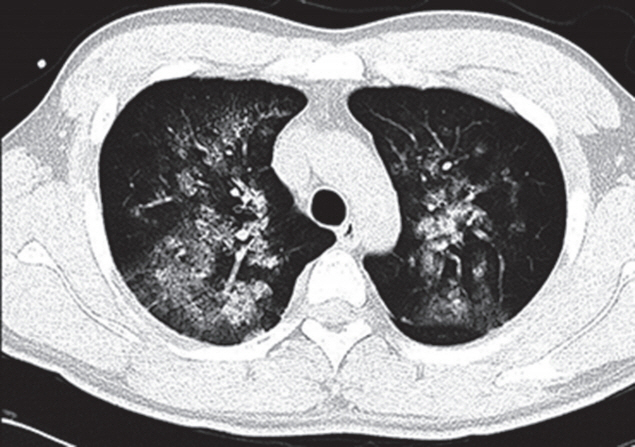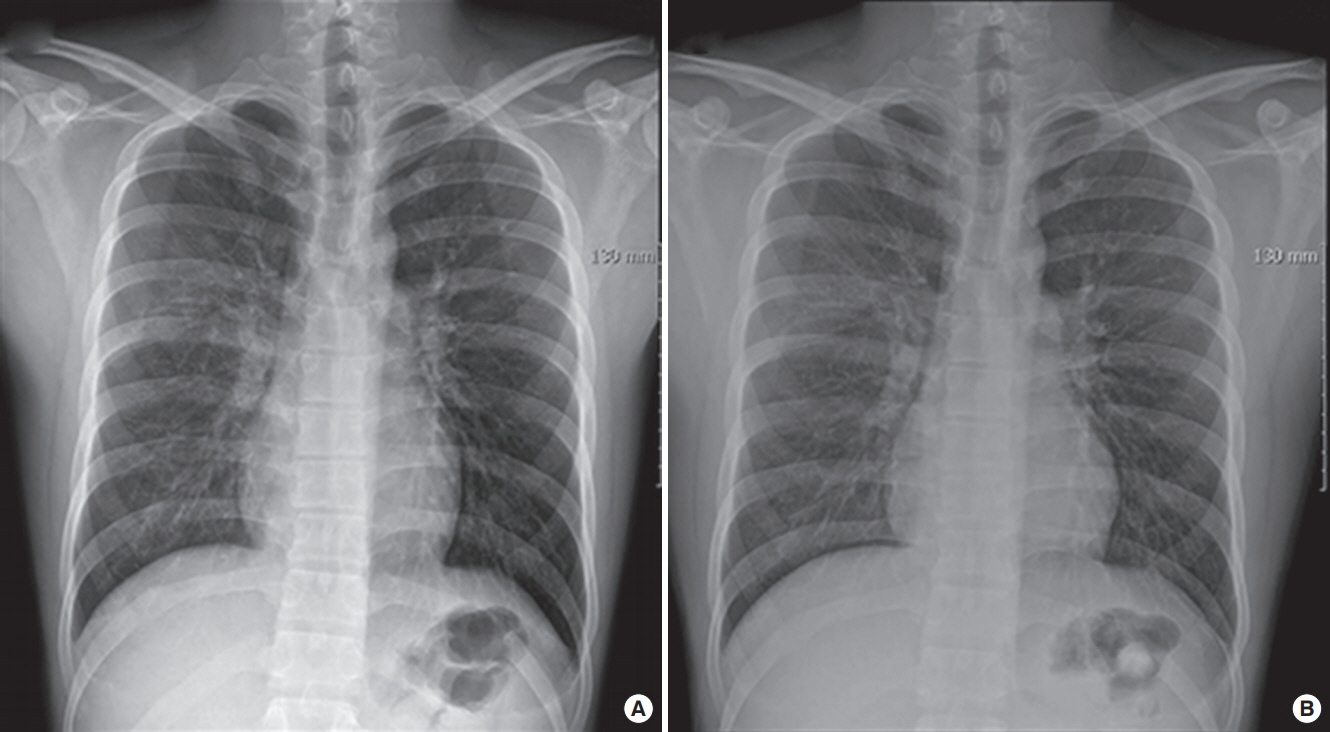Acute Crit Care.
2018 Aug;33(3):191-195. 10.4266/acc.2016.00689.
Negative Pressure Pulmonary Hemorrhage after Laryngospasm during the Postoperative Period
- Affiliations
-
- 1Department of Anestheiology and Pain Medicine, College of Medicine, The Catholic University of Korea, Seoul, Korea. anes36@catholic.ac.kr
- KMID: 2436333
- DOI: http://doi.org/10.4266/acc.2016.00689
Abstract
- Negative pressure pulmonary hemorrhage (NPPH) is an uncommon complication of upper airway obstruction. Severe negative intrathoracic pressure after upper airway obstruction can increase pulmonary capillary mural pressure, which results in mechanical stress on the pulmonary capillaries, causing NPPH. We report a case of acute NPPH caused by laryngospasm in a 25-year-old man during the postoperative period. Causative factors of NPPH include negative pulmonary pressure, allergic rhinitis, smoking, inhaled anesthetics, and positive airway pressure due to coughing. The patient's symptoms resolved rapidly, within 24 hours, with supportive care.
Keyword
MeSH Terms
Figure
Reference
-
1. Gavel G, Walker RW. Laryngospasm in anaesthesia. Contin Educ Anaesth Crit Care Pain. 2014; 14:47–51.
Article2. Olsson GL, Hallen B. Laryngospasm during anaesthesia: a computer-aided incidence study in 136,929 patients. Acta Anaesthesiol Scand. 1984; 28:567–75.3. Bhavani-Shankar K, Hart NS, Mushlin PS. Negative pressure induced airway and pulmonary injury. Can J Anaesth. 1997; 44:78–81.
Article4. Koch SM, Abramson DC, Ford M, Peterson D, Katz J. Bronchoscopic findings in post-obstructive pulmonary oedema. Can J Anaesth. 1996; 43:73–6.
Article5. Broccard AF, Liaudet L, Aubert JD, Schnyder P, Schaller MD. Negative pressure post-tracheal extubation alveolar hemorrhage. Anesth Analg. 2001; 92:273–5.6. Mulkey Z, Yarbrough S, Guerra D, Roongsritong C, Nugent K, Phy MP. Postextubation pulmonary edema: a case series and review. Respir Med. 2008; 102:1659–62.
Article7. Schwartz DR, Maroo A, Malhotra A, Kesselman H. Negative pressure pulmonary hemorrhage. Chest. 1999; 115:1194–7.
Article8. Papaioannou V, Terzi I, Dragoumanis C, Pneumatikos I. Negative-pressure acute tracheobronchial hemorrhage and pulmonary edema. J Anesth. 2009; 23:417–20.
Article9. Davidson S, Guinn C, Gacharna D. Diagnosis and treatment of negative pressure pulmonary edema in a pediatric patient: a case report. AANA J. 2004; 72:337–8.10. Zhurda T, Muzha D, Dautaj B, Marku F, Kurti B, Jaho E, et al. Acute posoperative negative pressure pulmonary edema as complication of acute airway obstruction: case report. J Anesth Clin Res. 2016; 7:603–6.11. Patel AR, Bersten AD. Pulmonary haemorrhage associated with negative-pressure pulmonary oedema: a case report. Crit Care Resusc. 2006; 8:115–6.12. Diab K, Noor A. Negative pressure pulmonary hemorrhage. Respir Med CME. 2009; 2:170–2.
Article13. West JB, Tsukimoto K, Mathieu-Costello O, Prediletto R. Stress failure in pulmonary capillaries. J Appl Physiol (1985). 1991; 70:1731–42.
Article14. Park MS. Diffuse alveolar hemorrhage. Tuberc Respir Dis (Seoul). 2013; 74:151–62.
Article15. Khanna AK, Cummings KC 3rd. Pulmonary hemorrhage in an outpatient ophthalmic anesthesia setting: it’s never “just a cataract”. J Anaesthesiol Clin Pharmacol. 2012; 28:520–3.
Article16. Lara AR, Schwarz MI. Diffuse alveolar hemorrhage. Chest. 2010; 137:1164–71.
Article17. Saeed AI, Quintana C, McGuire FR, Barker JA. Delayed presentation: negative pressure pulmonary hemorrhage. J Clin Anesth. 2012; 24:490–3.
Article18. Kim CA, Liu R, Hsia DW. Diffuse alveolar hemorrhage induced by sevoflurane. Ann Am Thorac Soc. 2014; 11:853–5.
Article
- Full Text Links
- Actions
-
Cited
- CITED
-
- Close
- Share
- Similar articles
-
- Postoperative negative pressure pulmonary edema following repetitive laryngospasm even after reversal of neuromuscular blockade by sugammadex: a case report
- Postobstructive pulmonary edema after laparoscopic surgery
- Negative Pressure Pulmonary Edema and Hemorrhage after Extubation: A Case Report
- Negative-pressure Pulmonary Edema by Doxapram-induced Larygospasm: A case report
- Pulmonary hemorrhage accompanied with pulmonary edema induced by endotracheal tube occlusion in a child: A case report




